By Pete Vack with comments and research by Daniel Cabart
(This great Delage has changed hands since this article was originally published in 2011)
The last time our readers heard much of Alex Vazeos was in an article about last year’s Ville d’Este, where he was the first entrant to brave the judges with an Etceterini, in this case the ex-Rafi Minasian Giaur. Seemingly bent on buying small Italian cars, Vazeos found others, including the purchase the editor’s old Abarth 750 Zagato to sit next to his Record Monza. Alex also owns the ex-Jack Reuter Bandini, an Abarth Simca 1300 Corsa and a very rare Moretti 1200 Grand Sport.
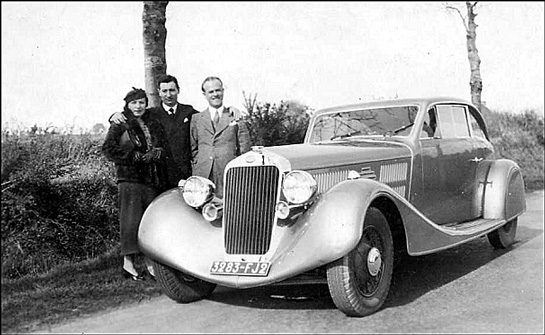
Mr. Le Guyader with family in France, circa 1935. This Delage is the only one of eight 105S to survive. Photo courtesy Daniel Cabart.
Then, in November of 2010, he sent an email. “How do you like that, it arrived two days ago” and thereupon surprised us with a Delage. It seemed inconsistent with his penchant for small Italians so we asked what attracted him to the large pre-war Delage. “Although I do love small Italian jewels,” said Alex, “I also love coach-built and rare cars and yet I’ve never had a French car of this caliber. I found the Delage to be an exceptionally elegant and rare car. So, when the opportunity had presented itself, I thought, why not and so the car became mine.” We were pleased; Vazeos’s taste in cars compliments the scope of VeloceToday.
In December we heard from Alex again. When he purchased the car, it was maroon and beige—not bad but with his friend Rafi Minasian, they tried to find the most subtle and easy way to give this exceptionally nice car a more elegant and Art Deco substance. Therefore, the beige was replaced by an off-white, which was achieved by mixing total white and the color of the interior. White wall tires were added and period correct discs, made by Lmaar (Lmaar.com) covered the wires which were dating the car a lot. Lmaar did an exceptional job. Finally, period photos revealed that the car had no bumpers so the remaining front bumpers were removed.
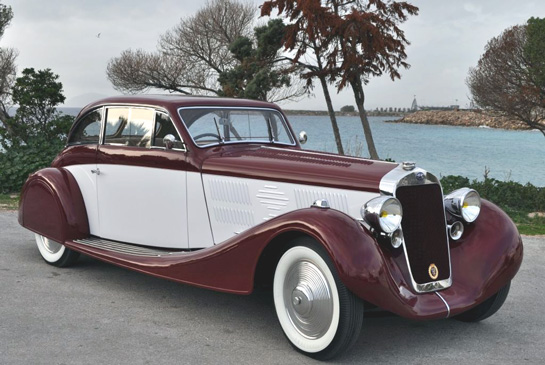
Subtle changes made after purchase suggested by Rafi Minasian included art deco wheel covers by Lmaar.com. Credit Alex Vazeos.
Immediately after buying the Delage, Alex started to do more homework on the car, getting in touch with the author of “Delage: France’s Finest Car”, Daniel Cabart to research the history of 40123 and correct previous false assumptions about this very interesting Delage. Cabart did so with his usual gusto, establishing a friendly relationship with Vazeos that will probably transcend the eventual movement of the car to another owner. (VeloceToday has previously reviewed Cabart’s book on the Delage, and they are republished in this edition of VeloceToday, free of the premium service. Cabart’s book is also available in the VeloceToday bookstore).
Ask the experts?
After sending us the first photos, Alex asked if we could identifiy his latest acquisition—he knew of course but was testing our level of expertise. Well, we weren’t going to be stumped. Right off it was clearly a Delage from the mid thirties. The body could have been designed by several French coachbuilders but the circular pattern of louvers on the hood was surely unusual. We consulted Cabart’s Delage “bible” and found that in October of 1934 the range of Delage cars was truly overstocked and included the D-4, the D-6, the D8-15 and two new models, the D8 85 and D8 105 for the 8 cylinder cars. But which one did Alex now own? We simply couldn’t tell from the photos Alex supplied. We withdrew in disgrace.
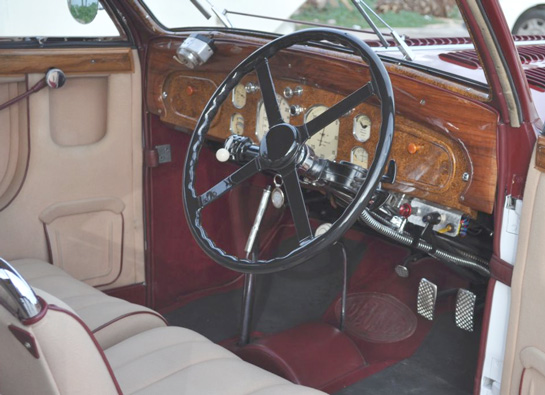
Interior of the Delage 105S. It was equipped with the excellent COTAL electric gearbox. Credit Alex Vazeous.
Fortunately, Cabart himself was on the way, doing further research into the history of 40123. He explained that when Louis Delage decided to create a new range of cars to add to the D6/11 and D8/15 he called in Arthur Michelat, who had originally joined Delage in 1910 and created the three pre-1914 Grand prix winner racers for Delage. After leaving Delage, Michelat had gone to Georges IRAT and CITROËN before being called back by Delage. He arrived in 1933 and immediately began to design the new line of six and eight cylinder cars. The new cars, dubbed the D6-65 and D8-85 were very modern designs, which included Bendix hydraulic brakes, and the electric Cotal gearbox, “much better than the Wilson pre-selector, and a must have”, said Cabart. In addition, the frame was underslung, giving a much lower line to the new Delages. Cabart would know that those circular louvers were a sign that the car was an eight cylinder—actually there were two circles making the number eight.
That in turn, meant the car had been designed by the famous Letourneur et Marchand. And that meant that it was a D8-105 and probably the hottest model available, the 105 S, with a special twin plug head. 105 meant 105 bhp, as initially rated, but with the twin plug special head, it was actually tested at 115 bhp @ 3800 rpm.
Sole survivor
Cabart said that only eight of these special 105 chassis were recorded in the Delage fabrication book. Autobineau made four bodies from this run and the AUTOBINEAU fabrication book lists them as such:
– 2 with “S” engine on “ S” chassis.(1 LHD and 1 RHD) (One J24 and one J 25)
– 2 with “S” engine on “L” (light) chassis. (1 LHD and 1 RHD) (One J24 and one J 25)
Two other D 8 105s were bodied by Letourneur et Marchand as convertibles, 2 doors 4 seats, one for a private customer, and the second one for Delage, to be displayed at Barcelona 1935 Motor Show.
Of the eight, only one survived—Alex’s new Delage, s/n 40123, which although designed by Letourneur et Marchand was one of the four bodies constructed by Autobineau. This streamlined body appears in the 1934/35 Delage catalogue and can be fitted on both D8 105 “S” and D8 105 “L” chassis, with the “S” engine on both. Says Cabart, “All the cars made by Autobineau were designed by the Letourneur et Marchand designers: Marcel Letourneur and Carlo Delaisse.
With a similar streamlined body (code J 24), it was tested on September 26th 1934 at Montlhéry hitting 152 km/h, the “L” version being capable of “only” 146 km/h.
Chassis 40123 with engine N° “6 S” was ordered on November 26th 1934, with agreement on the special fittings on January 28th 1935. The chassis arrived at Autobineau on February 6th, as can be read in the records of the coachbuilder’s book.
Needless to say, all of this made Alex a happy camper, or at least a happy Delage owner.
The first owner
Ownership chain is always important but none perhaps as important as the very first owner. Who were they, why did they buy the car, what was their effect on the final build and are there any photos? This is particularly difficult with many pre war European cars as so much was lost in the turmoil of WWII. But again, Alex—along with Cabart– had the Midas touch. Cabart told him that the first owner was a Mr. Le Guyader, who lived in Morlaix, not far from the resort town of Saint Briac, where Louis Delage had a summer home called La Campanella and also where he kept many boats. Le Guyader was a sailor who after retirement had established a company called LGM (for Le Guyader Morlaix) and had made a fortune making radio sets. Naturally he became a close friend of the car manufacturer. Le Guyader’s daughter recalled that her father’s unique pleasure was beautiful cars.
At the Finistère’s archives (in Brittany) Cabart found the records book for February 1935 showing that car # 40123 was registered new by Le Guyader with tags 3283 FJ 2 on February 2nd 1935. “This indicates that Mr. Le Guyader bought the car from Delage as a bare chassis before it was actually at the coachbuilder’s, and did the documents to have it registered in his department, while the car was under construction.” The car was delivered on March 3rd to Le Guyader.
“As delivered, 40123 was finished in metallic grey, which can clearly be seen on the two family pictures given to us by the Le Guyader family,” relates Cabart. “It already bears the two horns that could still be seen in the 70s and 80s.” Cabart says that D8 105 # 40123 was equipped with that impressive COTAL gearbox, but he has no idea if this gearbox has been fitted at the factory, or in 1936 when Le Guyader sold the car.
Other owners
After having been used by Le Guyader for more than a year, # 40123 was then sold in 1936 after Mr. Le Guyader had bought the Paris Motor-Show star, the Delage D8 120 Aerosport. It was then registered in Paris in October 1936 as 4286 RK 6, bought by Mr. Carabin. Following the change in registration scheme, Carabin then re-registered it in Paris in 1955 with the number 7046 DU 75, or perhaps by Mr. Petiet at the occasion of the change of ownership, when he was donated the car. Donated in 1955 to Mr Petiet, an antique dealer in Montlhéry for the future Museum expected to be set up by Serge Pozzoli. It was then sold to Chatellerault Museum where it was displayed for at least 20 years
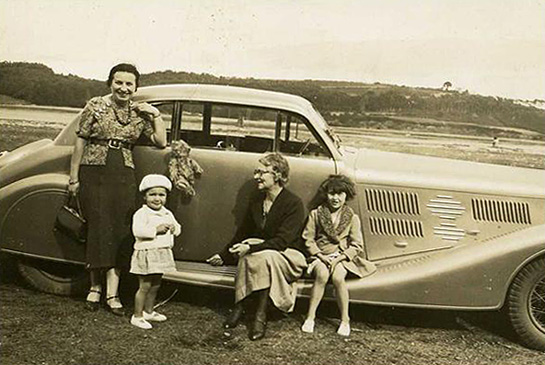
Le Guyader's family poses in front the Delage 105S. Not the two rounded louvers. Courtesy Daniel Cabart.
Impressive history, and, according to Cabart, “This and all the technical particulars make of this unique car a very special and valuable one. Being the last study (1934) made by the Delage company founded in 1905, this powerful and innovative 8 cylinder Sports model is the swansong of a name which has won in 1927 the title of World Champion.
Alex Vazeos on driving his Delage
“The car is so easy to drive! Although it is nose-heavy, it doesn’t feel like it. The suspension, rather advanced for the time, is very compliant and the car feels very solid and relatively unaffected by the elements of daily traffic. It does need to be properly warmed up though, like most prewar cars but it starts instantly, keeps a very low idle and never overheats. It is not fast off the line but when you manage to pick up speed, it keeps it effortlessly. Speeds in excess of 60-70 mph are easily achievable with no problem at all. The Cotal electric gearbox works like a breeze and makes the whole experience very rewarding. It is very simple to use, the changes are reasonably smooth and suits perfectly to the character of the car. The car feels more like 50s (even late 50s…) than early 30s. It was over engineered back then and it shows, even today.”
And then—
*Arthur Michelat followed Louis Delage with the new company created in October 1935 and created a new range of Delage cars.
*In 1935, Walter Watney bought the name Delage and had created a company “SNAD” (then SAFAD in 1937) to sell cars created by a Delage team (managed by Louis Delage, among the engineers Arthur Michelat). The new cars were sold by SNAD, with the chassis manufactured by Delahaye and the bodies made outside. They were assembled on the Delahaye lines.
*Louis Delage, the founder and driving force of the great Delage marque died on December 14 1947.
*The Delage name would disappear in 1954.
*Daniel Cabart is, according to Vazeos, “a great lover of Greece and speaks Greek very fluently since he has spent many years of his life in Greece! So, from the very beginning, we connected very well and in fact, he was very pleased that a car that he’s lost track for quite a few years, suddenly “emerged” in his favorite country!”
*And Vazeos? “The car won the Best of Show at 2006 Essen and since then, it has never appeared at any European concours event. It was shown though at the Marine Sonoma concours in 2009 where it won a Class award. I hope to show it at several events in 2011.”
For more on Delage:
Read Delage Book Review

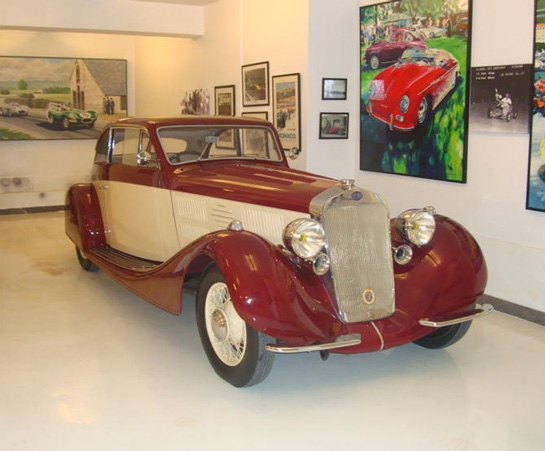
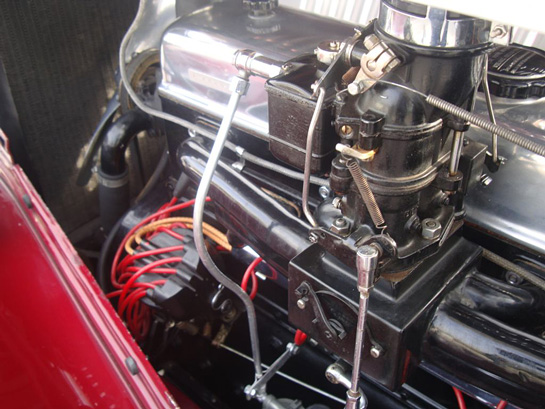
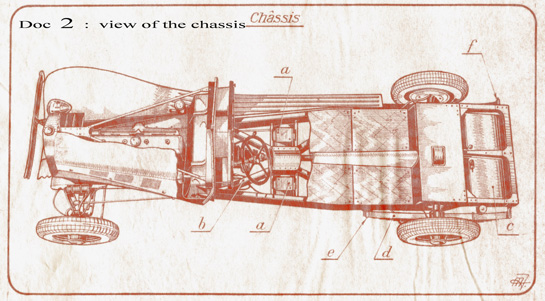
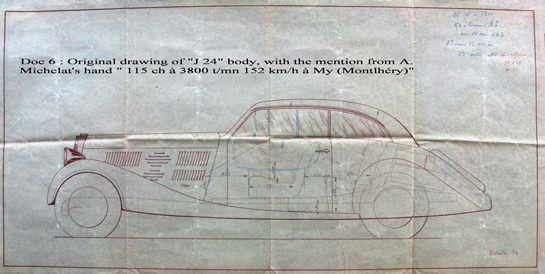
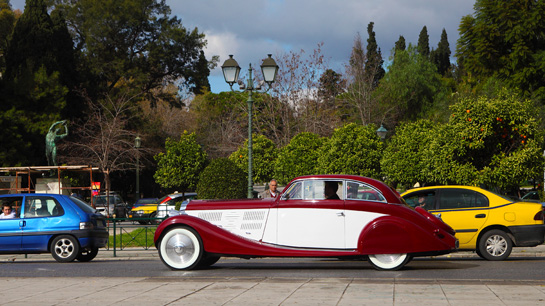
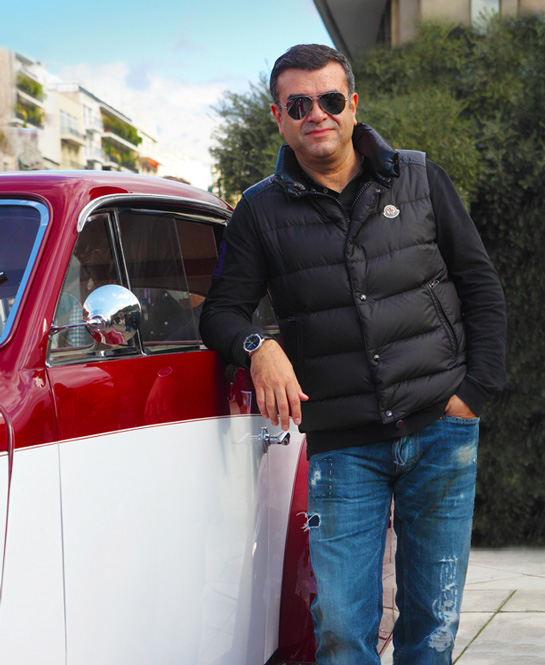
Great history, great car and great owner. Congrats, Alex!
It is a real pleasure to read this article and learn more about this “one survivor” of a great marque.
Having photographed extensively Alex’s jewel of the crown, now I can share this article with many motorhead friends.
Thanks guys, thanks Alex!
Wonderful article on a wonderful car!! The history now makes this beautiful car all the more special and important to the Delage lineage. Congrats to Alex and many thanks for the opportunity to contribute design efforts to this fine car.
That Delage is gorgeous – especially with the two-tone paint job. I’m grateful to Alex for sharing its history and photos with us.
I wish that I could see one photo of this car.
I drove the Delage of Herb Lozier in the 1950’s. It could be the subject of small article, but is bigger than this submission box